Table of Contents
- How to Create a Pest Control Business Marketing Plan
- How Much Should Pest Control Companies Invest in Marketing and Advertising?
- 1. Traditional Marketing Strategies for Pest Control Companies
- 2. Digital Marketing Strategies for Pest Control Companies
- 3. Local Marketing Strategies for Pest Control Companies
- 4. Pay-Per-Click Advertising Strategies for Pest Control Companies
- 5. Customer-Centric Marketing Strategies for Pest Control Companies
- 6. Seasonal Promotion Ideas for Pest Control Companies
- 7. Bonus: Eco-Friendly and Sustainable Marketing for Pest Control
- Final Thoughts
The pest control market is buzzing. To stand out, your company needs a well-rounded pest control marketing strategy that fosters long-term relationships with clients.
Whether you’re looking to start a pest control business or scale your business to serve new customers, we’re here to help. Below, we explore a range of marketing ideas for pest control companies that will help you attract and retain customers.
How to Create a Pest Control Business Marketing Plan
The foundation of any successful and effective marketing strategy is a solid plan. This is not something you think up on the fly but rather a portfolio of intentional, well-researched pest control advertising ideas that resonate with your ideal customer.
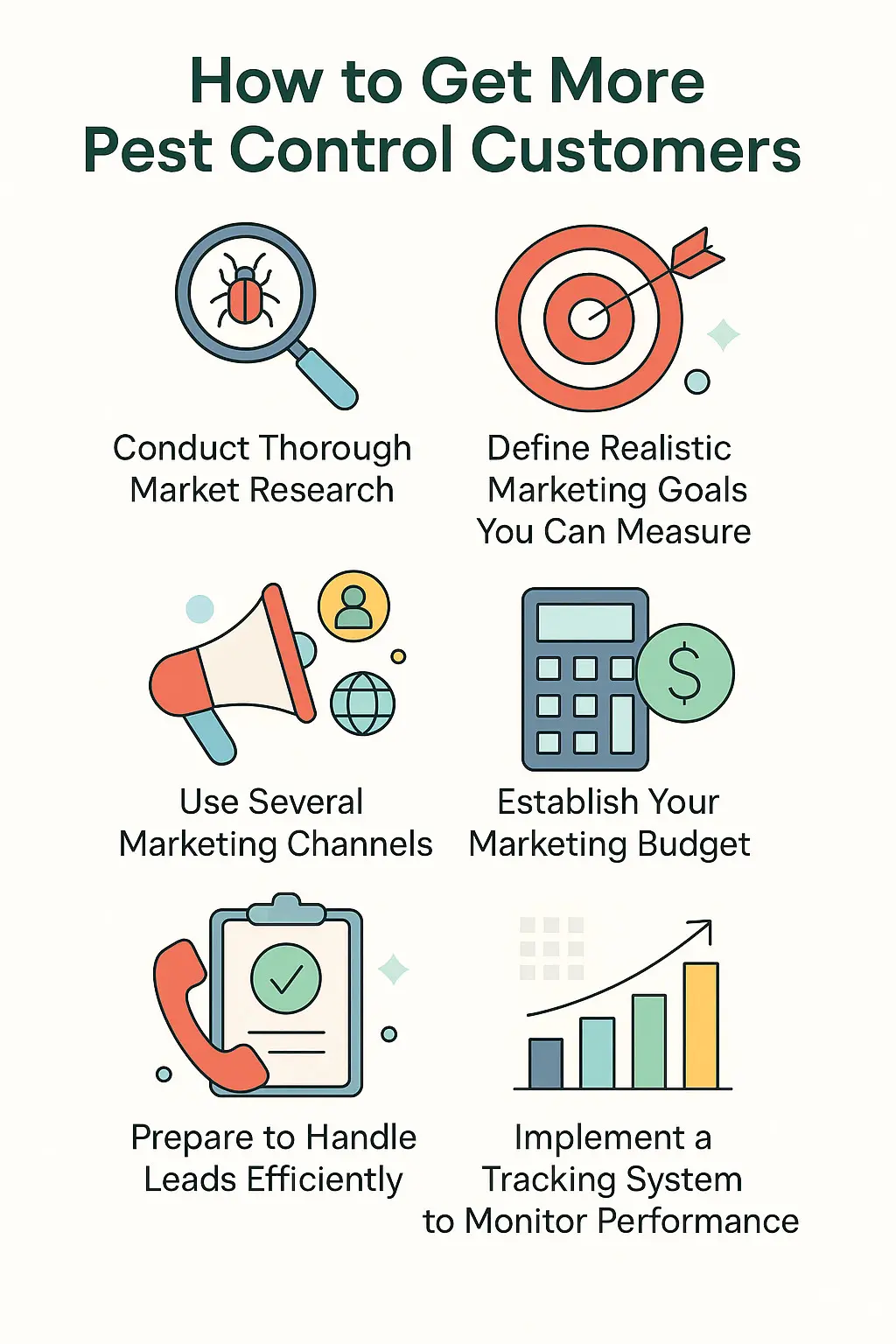
Here is a step-by-step guide on how to get more customers:
Conduct Thorough Market Research
Gather real-world data on local pest issues and the customers who face them. This will help inform the services you can offer to address the problems homeowners face regularly. Join local Facebook groups or Nextdoor neighborhoods, where residents might discuss bug problems and ask for solutions. Note any recurring questions or complaints to narrow down the products and services that might help them.
Define Realistic Marketing Goals You Can Measure
What do you want to achieve with your marketing plan? Set one to three measurable goals you want to address, such as increasing monthly leads by 20% or creating an online presence to boost engagement by 10%, and prioritize marketing strategies to hit them. For example, you might pay for Facebook ads to attract more leads or build a website to introduce yourself to local customers.
Use Several Marketing Channels
Ideally, your pest control marketing campaign focuses on multiple strategies instead of just one to boost results and exposure. Focus on where your audience typically seeks help (e.g., Google, Nextdoor, the opinions of friends and family, etc.) and advertise your business on those platforms.

Ads on social media can be tailored to your marketing budget. Simultaneously setting up profiles on local directories that allow you to collect online reviews, like Google or Angi, is also a low-cost way to increase your awareness on sites that customers frequent.
Establish Your Marketing Budget
Allocate adequate resources for advertising, traditional ads, and other marketing channels. When planning your budget, consider your potential revenue (like the average pest control salary in your region) and your business needs. Understand that your marketing expenses are recurring monthly charges.
Prepare to Handle Leads Efficiently
As your marketing efforts generate more income, use a project management tool like Jobber or Service Titan that streamlines invoicing, the ability to accept online payments, and scheduling.
You might also consider tools that help you respond to a higher volume of customer inquiries, such as AI chatbots for your website and online contact forms.
Implement a Tracking System to Monitor Performance
Use tools like Google Analytics or a Customer Relationship Management (CRM) platform to analyze how your marketing efforts perform. After all, you won’t be able to grow your business unless you know what works and what doesn’t. CRMs have features that can support a growing pest control business, including reporting capabilities to monitor performance and integrations with email marketing software.
Lean on your software to track key performance indicators, such as:
- Changes in website traffic
- Number of incoming calls or online form submissions
- Conversion rates
- Social media engagement
- Digital ad spend
How Much Should Pest Control Companies Invest in Marketing and Advertising?
Determining a budget for pest control marketing often comes down to balancing your current finances with long-term growth goals. While there isn’t a universally accepted formula, we suggest spending between 5% and 15% of your revenue on marketing, depending on how established your business is and how quickly you want to grow.
If your company is new, getting your company out into the world might require a higher upfront investment to build your brand identity and online presence on a variety of platforms. More established companies, on the other hand, might focus on one or two marketing channels that have performed well for them historically, like community sponsorships and/or retargeting ads on social media. (More on this below.)
Another factor to consider is your local market and competition. If you’re in an especially competitive region, you may need to boost your spending to stand out. Smaller markets might be able to rely more on word-of-mouth, referrals, and grassroots communication. Regardless of your approach, make sure to measure your return on investment and adjust your plan as needed.
1. Traditional Marketing Strategies for Pest Control Companies
While most new business owners might think to focus on digital marketing, it’d be a mistake not to consider traditional marketing methods as a powerful tool for establishing local credibility and engaging potential customers.
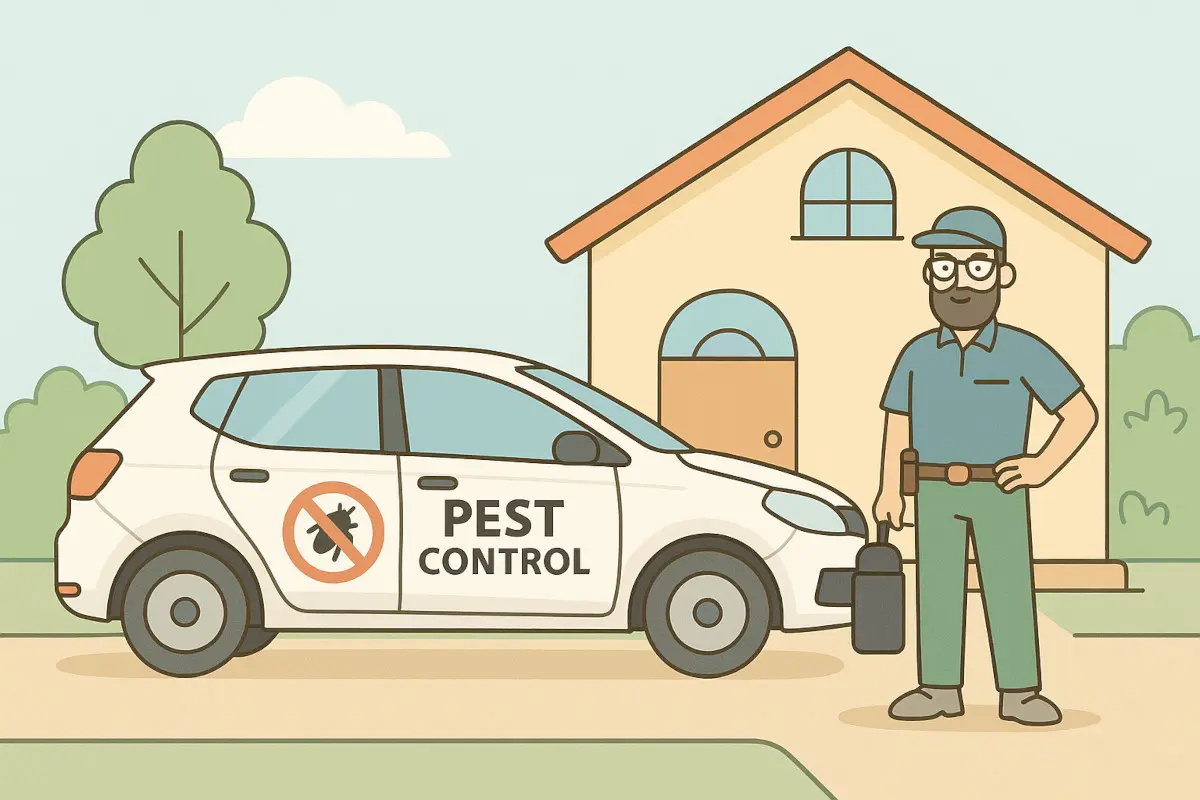
Below are some of the most effective traditional marketing strategies, each tailored to help you stand out in a crowded marketplace.
Print Advertising
When you want to put your business in front of homeowners, there’s no better way than through the mailbox. A recent study found that direct mail has a response rate as high as 9%. Flyers and door hangers are a cost-effective and highly targeted way to raise your brand awareness. You distribute them in neighborhoods across your service area or hang larger advertisements at local community centers.
Business Cards
A business owner must always have business cards at the ready. They’re inexpensive and portable — perfect for networking events or spontaneous encounters with prospective clients. When designing your cards, make them reflect your brand’s identity. It should include your logo, color palette, and tagline, as well as your name and contact information.
Customer Referral Programs
Word-of-mouth is a powerful driver of sales, as customers are more likely to trust the opinions of friends and family when making a buying decision. Plus, data suggests that referred customers bring in between 30% and 57% more new customers than others to a business by sharing their experiences with their network.
Formalize a customer referral process by offering an incentive, like a discount or gift card for each referral. Simplify this process by giving customers a trackable coupon code or online referral link, and then encourage referrals in your follow-up emails, service contracts, and website.
Branded Vehicles and Uniforms
Eye-catching vehicle wraps with your logo, website, and phone number act like moving billboards, helping local residents recognize your company. Similarly, uniforms give off a professional vibe to customers as you show up at their door.
Local Partnerships and Sponsorships
The more active you are in your community, the more chances you have to interact with potential customers. Partner with local businesses or sponsor community events that have similar audiences. Home improvement stores, property management companies, real estate offices, or local cleaning services that cater to homeowners are all great examples of mutually beneficial partnerships.
In exchange for publicity, you might provide a free pest inspection for a school fundraiser or partner with a nearby gardening center to give talks on pest prevention.
Trade Shows and Industry Events
Even in a digitally dominated world, trade shows and industry events remain effective for networking and meeting prospects face-to-face. Nearly 46% of trade show attendees are executives or upper managers, meaning you’re likely to connect with decision-makers who can initiate valuable contracts for commercial pest control services.
Broadcast Advertising
TV and radio advertisements can help position your pest control business as a local authority. Well-placed spots during relevant programming, such as home improvement shows or morning news segments, target homeowners who are already thinking about property upkeep. This type of advertising is a costly endeavor, but if your revenue supports it, media placement can reach thousands of potential clients in little time.
Outdoor Advertising
Billboards, bus stop ads, and yard signs are all examples of outdoor advertising that can boost visibility in your service area. You’ll usually pay a monthly fee to run a billboard or bus ad, but you can make yard signs in bulk for a much lower price. Yard signs you stake in the ground following the service also encourage referrals from locals in the same area.
2. Digital Marketing Strategies for Pest Control Companies
With most customers relying on the internet to find and evaluate local services, it’s almost impossible to attract customers without a strong digital presence. Here are some of the most effective digital pest control marketing strategies to elevate your business.
Professional Website Optimized for Mobile
Your website often gives customers the first impression of your pest control business. Therefore, the experience must be simple, easy to navigate, and informative. At the very least, your website should include the following elements:
- A simple contact form
- Clear service pages
- Reviews and testimonials (more on this below)
- Calls to action, such as “Request a Quote” or “Schedule an Appointment.”
Incorporating photos of completed projects and staff introductions can humanize your brand: this will set you apart from competitors who rely on generic layouts.
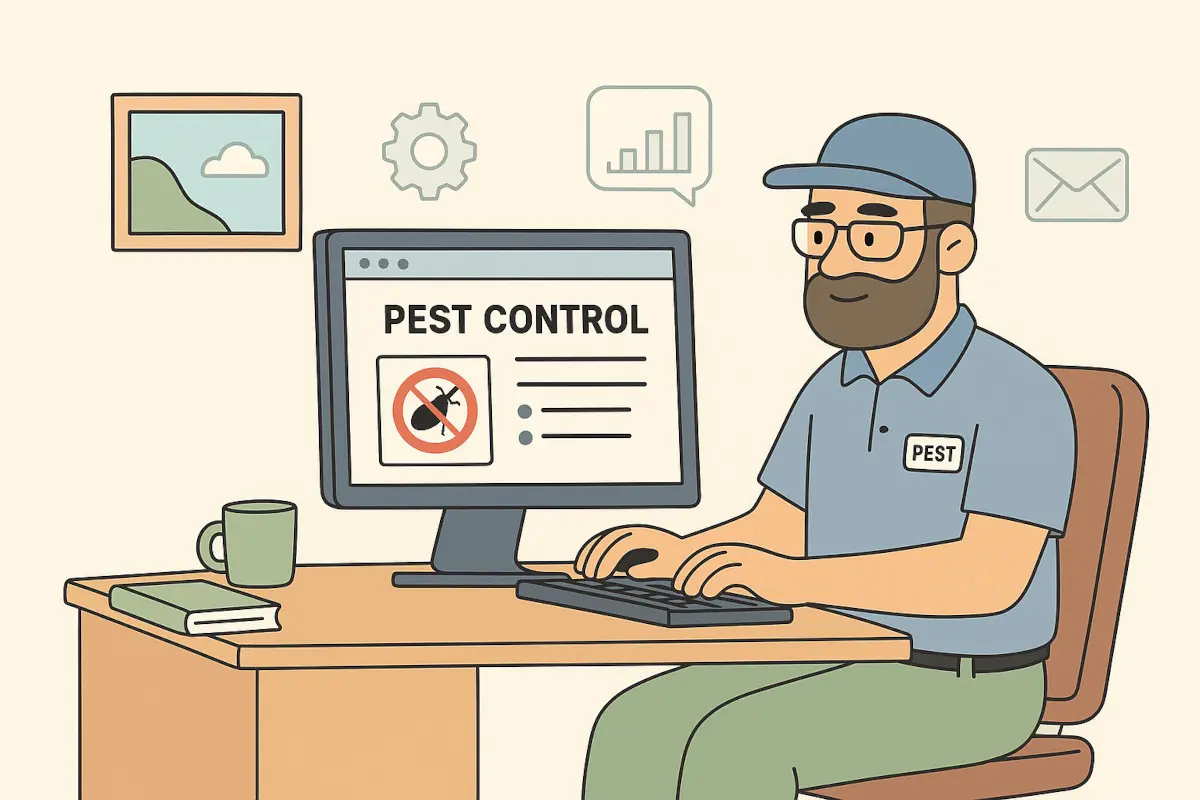
Transparent pricing and timelines will help your customers feel at ease. Your website can be a good tool for displaying your options for pest control payment plans, warranties, and satisfaction guarantees.
Mobile-friendly websites are not only an SEO play (more on this later), it’s a requirement. Roughly 63% of local Google searches occur on mobile, which means you must consider how your website will look when accessed using a smartphone. If prospective customers can’t navigate and learn on their screens, they’ll leave. Most website builders include this functionality in their designs, but here are a few other mobile-friendly elements to consider implementing:
- Large, finger-friendly buttons for easier navigation
- High-contrast color schemes
- Reduced file sizes and caching codes to prevent slow loading
SEO
Search engine optimization (SEO) is about helping your website rank higher on Google and other search engines. When your website is optimized, it can help you appear in more searches (read: make it easier for people to find you and click on your website).
Conduct thorough keyword research to determine the right words and phrases you need to add to boost visibility. Then, implement your findings into your page titles, meta descriptions, headers, and content — which signals to search engines that your content is relevant.
Google Trends is a tool that can show you search trends for related pest control topics, such as a spike in searches for “pest control contractors near me” and other popular searches like “flea exterminator” or “pest control services” or “termite exterminator cost.” These insights help you tailor your services and marketing messages to match what homeowners urgently need and want.
These keywords can also inform what you write in your blog posts, service pages, and meta descriptions. Keep in mind that SEO is a long-term strategy, so it might take weeks or months to see tangible results. However, when done right, your exposure can be significant.
Content Marketing (Sharing Helpful Content Online)
Quality content paired with SEO can help position you as a trustworthy and credible resource in pest control. A successful content marketing strategy should include a variety of content posted on a variety of channels.
For example, you might create blog posts discussing popular pest-related topics on your website, share how-to guides and checklists on social media, and upload videos full of helpful tips and insights — all of which attract customers to your platforms and help generate awareness of your brand.
Blog ideas:
- A monthly post on seasonal pest prevention
- How-to guides on common repairs and fixes
- Articles about common causes of rodents
- Inspirational write-ups for mosquito control or bug deterrents
Social media marketing ideas:
- Sharing photos from the field
- Posting recent customer testimonials
- Advertising special promotions
Video marketing ideas:
- Share before and after reels
- Livestream a repair
- Showcase inspection processes and treatment methods
- Review new products
Video is a highly engaging format for bringing pest control topics to life. About 87% of people have been convinced to buy a product or service by watching a video.
No matter where you decide to share content, engagement is key. Respond promptly to comments, questions, and messages, and encourage satisfied clients to share their experiences.
Email Marketing
Email is a low-cost way to stay in touch with your customer base. Send out newsletters with seasonal tips, service updates, and exclusive offers that encourage clients to take action. For instance, you can remind subscribers to book their pre-season inspections or provide basic DIY pre-prevention tips to keep their minds on your services.
While email is an effective engagement strategy, it can be time-consuming to send emails to all your potential, current, and past customers. Leverage an email marketing tool like Mailchimp or Constant Contact to automate your campaigns, segment your lists according to preferences or needs, and track results.
Online Reviews and Reputation Management
Social proof in the form of reviews and testimonials plays a major role in influencing consumer decisions. A whopping 98% of customers read online reviews for local businesses, and many trust them just as much as a recommendation from friends or family.
Encourage satisfied customers to leave feedback on platforms like Yelp, Google, and Facebook. Make this process simple by providing direct links in follow-up emails or text messages after a service call. You can even offer incentives to get more reviews.
Make sure you respond to all feedback in a timely manner (even the negative reviews). Your public responses give customers an idea of your service principles and commitment to customer satisfaction. An easy way to do this is to set up a Google Alert for your business, which can alert you when someone mentions you or your employees online.
3. Local Marketing Strategies for Pest Control Companies
As a small business, it’s likely that most of your clientele will come from surrounding neighborhoods and nearby cities. Therefore, it’s worth focusing much of your marketing efforts on hyper-local tactics so customers know who to turn to in their community for help.
Here are some localized marketing strategies to consider.
Local SEO
We briefly mentioned that generalized SEO helps you rank on search engines in various locations. However, you can also employ local SEO strategies to help increase your online visibility when people search for location-specific keywords, such as “pest control in Salt Lake City.”
When paired with your general SEO strategy, the following local strategies can also come in handy:
- Make sure your name, address, and phone number are listed the same across all platforms
- Incorporate local keywords into your pages, blog posts, and meta tags
- Get on local directories like Yelp, Angi, and HomeAdvisor
- Analyze the keywords and content structure of top-ranking pest control businesses in your city
- Include a page of locations you serve on your website to incorporate location-specific keywords.
Again, reflect back on your general SEO research and use those tools to identify location-specific terms and long-tail keywords that include your city or region. You might use phrases like “exterminators in New York City” or “online estimates for pest management in Charlotte, NC.”
Google Business Profile and Map Listing
Google Business Profile (GBP) is one of the most powerful tools for local visibility because it uses local SEO strategy for pest control to show your company in Google Maps results and local search results. In fact, Google states that customers are 70% more likely to visit and 50% more likely to consider purchasing from businesses with a complete GBP.
To start, claim your listing on Google. Then, optimize your profile by choosing the correct categories and subcategories, verifying your listing, and updating it regularly. Google maintains a library of support articles that walks you through each step.
Adding high-quality photos that reflect your professionalism and connect your social media accounts to your GBP so your activity online will also show in Google.
Local Business Directory Listings
Yelp, Angi, and Thumbtack are additional getaways for expanding your online presence to reach more people. Many homeowners start their search on these platforms, so set up a complete and updated profile, including clear descriptions of your services, relevant keywords, and photos or videos of your work. Maintaining multiple listings also boosts your chances of appearing in organic search results.
Keep in mind; however, some of these directories charge listing or lead fees, often on a pay-per-lead basis, which can range from $15 to $60 per lead.
Geotargeted Advertising
Geotargeted advertising allows you to focus your marketing efforts on a specific geographic area, usually cities or ZIP codes. This ensures your creative ads appear only to those who are likely to become paying customers.
Most major ad platforms, including Google Ads and Facebook Ads, have built-in geotargeting features that help you set up these campaigns by location. In Google Ads, you can select “Locations” when creating or editing a campaign, then input the ZIP codes, cities, or radius you wish to target. Then, you’ll develop your ad copy based on your customers’ demographics, behaviors, and interests.
Community Outreach and Education
Position your company as a trusted community service by offering workshops and seminars. You can host live Q&A sessions at a local library or collaborate with a homeowner association to provide educational materials on pest control best practices.
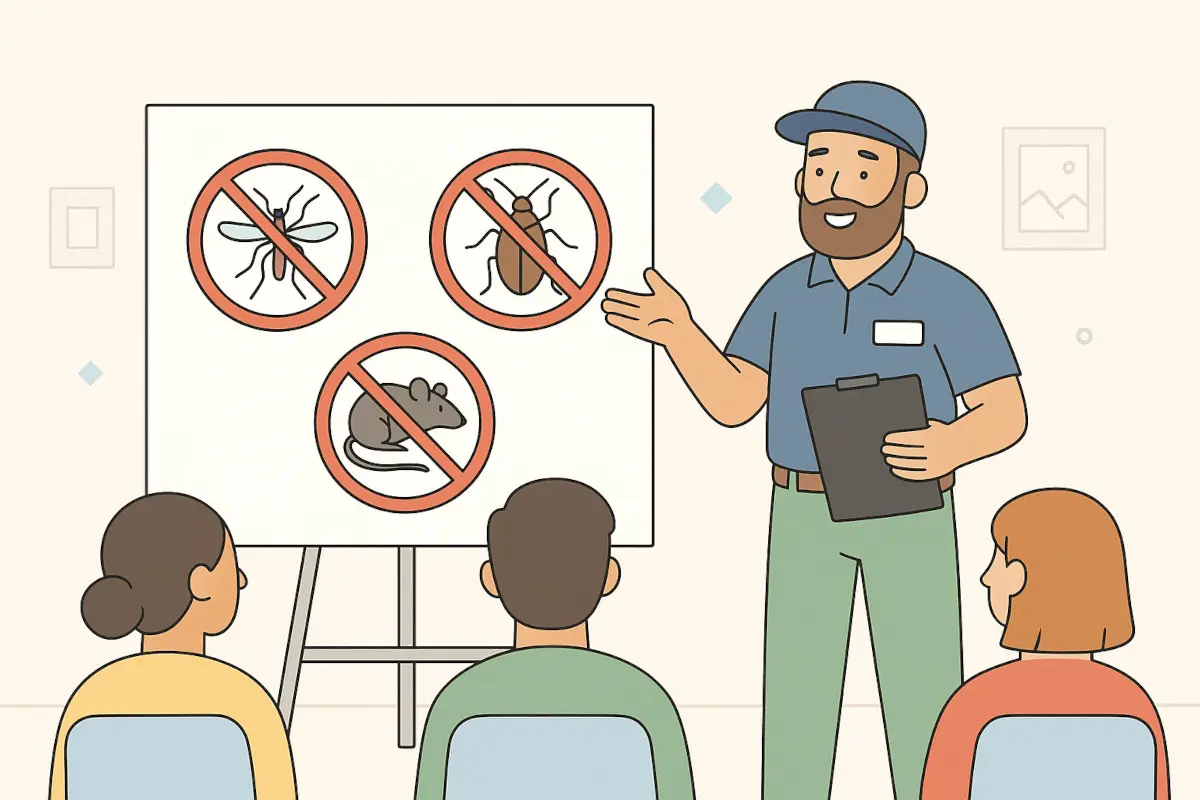
What’s more, you could start an educational series on social media or YouTube, helping increase your expertise in pest control. When residents view you as knowledgeable, they’re most likely to remember you and call when they need you.
4. Pay-Per-Click Advertising Strategies for Pest Control Companies
PPC advertising is a valuable part of any marketing campaign because it keeps your budget low and ROI high. Unlike traditional advertising, where you pay for your advertisement upfront, you’ll only pay when someone clicks on your PPC ad. It’s a targeted approach that helps you reach high-intent leads who are ready to take action.
Here are some key PPC channels to consider for your pest control marketing mix.
Google Ads
Google Ads lets you bid on keywords like “termite treatment near me” or “24/7 rodent control,” prioritizing your listing in what’s known as the “three-pack.” To do this, you’ll bid on words and phrases — keywords your customers are most likely to search — and then your ad will be featured in the local service section of Google above the generic search results.
These types of ads will require some testing to figure out which keywords work for you. Luckily, you can monitor your campaign’s performance through Google Ads’ built-in analytics tools, which track metrics like click-through rate (the percentage of people who click on your ad) and cost per acquisition (how much you paid to engage each customer).
Facebook and Instagram Ads
Social media ads are another way of targeting specific audience groups in a certain region, and they allow you to diversify your strategy on Facebook and Instagram. Craft visually appealing ads that highlight your company’s unique selling points and include a clear call to action on the ad that links to your page where a user can schedule an inspection.
Through a professional business Meta account, you can track engagement and conversion and adjust your targeting or budget based on the data. Social media ads typically run on a daily budget, such as $10 to $50 per day.
Retargeting Ads
Retargeting ads are shown specifically to users who have already visited your website but haven’t yet taken the desired action (e.g. contact you or get a quote). To enable retargeting, you typically install a small snippet of code, often called a “pixel” or “tag,” on your site that tracks user visits. You can run these ads on the Google Display Network or Facebook.
Once this is enabled, you can create retargeting ads that show up as they browse online later. Think of it as a friendly reminder aimed to nudge them to finally pick up the phone or fill out your contact form. Offer a limited-time discount or a free inspection on these ads to prompt immediate action.
5. Customer-Centric Marketing Strategies for Pest Control Companies
A streamlined business model and exceptional customer service can often outperform even the most creative ad campaigns. Why? Because satisfied customers turn into loyal promoters who leave positive reviews, refer you to friends and family, and ultimately do much of your marketing for you.
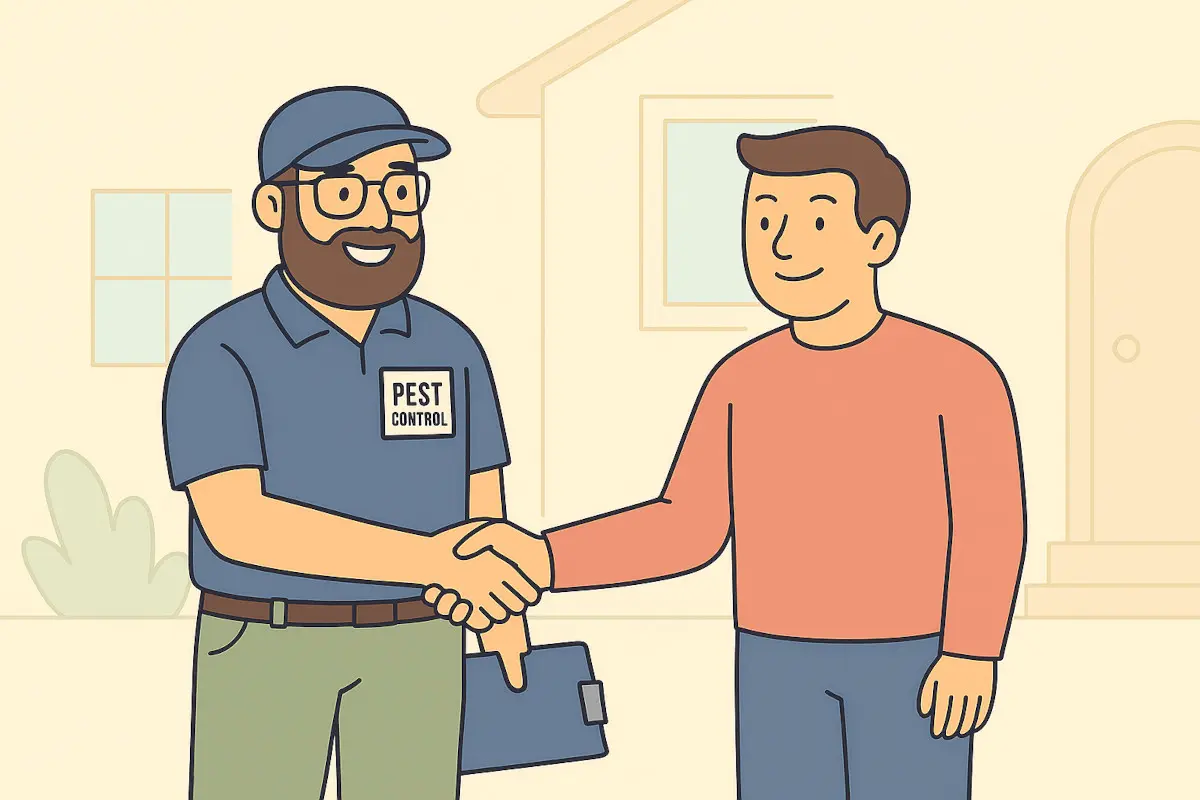
Increasing your customer retention rate by just 5% can generate 25% to 95% in new profits, so it’s important to nurture current customers through excellent service.
Personalized Communication
From sending friendly appointment reminders to addressing clients by name, these personalized tactics show that you value each customer as an individual. Tailoring solutions based on their specific pest issues and property type can also help build trust. Consider offering in-home consultations and detailed service breakdowns in your contract based on your visit to start off on the right foot.
Responsive Customer Service
Timely responses, whether via phone, email, or live chat, can be a game-changer for customers in need of an immediate solution. A reassuring voice on the other end of the line can go a long way in turning inquiries into confirmed bookings.
Offer same-day appointments, if possible, or emergency hotlines, which can set you apart and foster trust. Have on-call technicians ready during peak seasons, and use scheduling software to quickly assign incoming requests so no lead slips through the cracks.
Quick Response Time
Responding to service calls or quote requests within one business day signals respect for your client’s time and urgency. If you can’t be available 24/7, use an auto-responder that promises a follow-up within a few hours or an SMS service that allows you to communicate via text after hours.
Transparent Pricing and Service Details
Be upfront about fees, treatment scope, and potential follow-up visits to build credibility and curtail misunderstandings. Create a simple pricing chart or brochure that clearly outlines each service level, add-ons, and payment plans. Share it on your website and in email communications so clients know exactly what to expect.
For larger jobs or multi-visit plans, offering financing options or structured payment plans to your customers can broaden your customer base and make your services more accessible.
Flexible Scheduling Options
Life is busy, and homeowners appreciate a company that respects their schedule. Offer weekend or evening appointments to make it easier for people to fit pest control services into their daily routine without sacrificing other commitments. Use an online booking system with real-time availability that allows customers to pick a date and time slot instantly to save back-and-forth emails and lock in appointments faster.
Customer Loyalty Programs
Whether it’s a discount on future services or a points-based system leading to a free inspection, loyalty programs reward current customers and encourage them to keep coming back. Send out periodic loyalty updates via email or text, reminding customers of their points balance or how close they are to earning a free service. By integrating these incentives with referral bonuses, you can also motivate loyal customers to spread the word to friends and neighbors.
Listening to Feedback and Addressing Concerns
As you earn more online reviews and customer feedback, implement a monitoring schedule to ensure you can make adjustments as needed. Implement a quick survey via SMS or email immediately after a service visit, and follow up personally on responses that indicate dissatisfaction. If an issue arises, such as an unresolved infestation, address it quickly and put processes in place to ensure it doesn’t happen again.
Continuous Improvement
Finally, stay updated on new pest control treatments, technology, and safety protocols. Invest in staff training to ensure your team consistently delivers top-notch service. Organize these training sessions at least quarterly for your team, focusing on emerging pest control trends and customer service best practices.
6. Seasonal Promotion Ideas for Pest Control Companies
Pest activity fluctuates throughout the year, so timing your promotions to match the current need can help ensure you make consistent, year-round profits.
Pre-Season Inspection Offers
Before the peak season kicks into gear, entice customers with a discounted or free pest inspection. Advertise these early-bird deals through direct mail or targeted social media ads in the month leading up to peak season, emphasizing how proactive solutions cost less in the long run. Catching small issues early not only saves clients money but also builds trust, as they’ll see you’re focused on preventive care rather than just emergency fixes.
Seasonal Packages
Group treatments for pests that emerge heavily during specific times of the year, such as termites in spring or rodents in fall, into convenient bundle deals. This approach helps clients quickly understand what services they need right now and encourages them to address multiple pest concerns in one go.
Label these packages by season with creative names like “Spring Safeguard” or “Autumn Shield.” Detail exactly which pests and treatments are included in each package, so customers can easily see the value and timing of each offer.
Post-Season Pest Prevention Follow-Up
After peak pest activity subsides, remind customers to schedule follow-up visits or preventative treatments. Sealing entry points, setting up traps, or applying residual barriers can minimize future infestations. Provide them with a simple checklist of preventative measures they can do on their own, like trimming shrubs or storing pet food securely, and offer a discounted post-season assessment to ensure their home stays pest-free until the next season.
7. Bonus: Eco-Friendly and Sustainable Marketing for Pest Control
As customers become more environmentally conscious, businesses that adopt “green” methods can stand out in a meaningful way. This shift makes eco-friendly pest control solutions, like low-toxicity treatments and Integrated Pest Management (IPM), both a competitive advantage and a genuine contribution to sustainability.
Effective eco-friendly marketing starts with transparency about the products and techniques you use. Highlight certifications like GreenPro or the use of IPM strategies that minimize chemical applications and focus on preventative measures. Demonstrating a genuine commitment to protecting pollinators, children, and pets will go a long way in building loyalty and trust among customers who prioritize green solutions.
To amplify your message, create educational content on your website and social media about how eco-friendly treatments work. Include also tips for homeowners to maintain pest-free and sustainable environments. This could include guides on natural repellents, proper waste disposal, and sealing entry points — all of which demonstrate a proactive, environmentally mindful approach.
Finally, consider partnering with local environmental groups or community gardens to further underscore your commitment to sustainability. Sponsoring workshops or offering free eco-friendly consultations can spark word-of-mouth referrals and strengthen your brand’s reputation.
By integrating green practices into both your service offerings and marketing, you’ll appeal to the growing segment of customers who want effective pest control solutions without compromising the health of their families or the planet.
Final Thoughts
Thriving in the pest control industry calls for a well-rounded marketing plan that combines traditional, digital, local, and customer-centric strategies. By consistently delivering great service, staying responsive to client needs, and adapting your promotions to each season, you’ll stand out in a crowded market and encourage the positive word-of-mouth that drives long-term growth.
Table of Contents
- How to Create a Pest Control Business Marketing Plan
- How Much Should Pest Control Companies Invest in Marketing and Advertising?
- 1. Traditional Marketing Strategies for Pest Control Companies
- 2. Digital Marketing Strategies for Pest Control Companies
- 3. Local Marketing Strategies for Pest Control Companies
- 4. Pay-Per-Click Advertising Strategies for Pest Control Companies
- 5. Customer-Centric Marketing Strategies for Pest Control Companies
- 6. Seasonal Promotion Ideas for Pest Control Companies
- 7. Bonus: Eco-Friendly and Sustainable Marketing for Pest Control
- Final Thoughts


